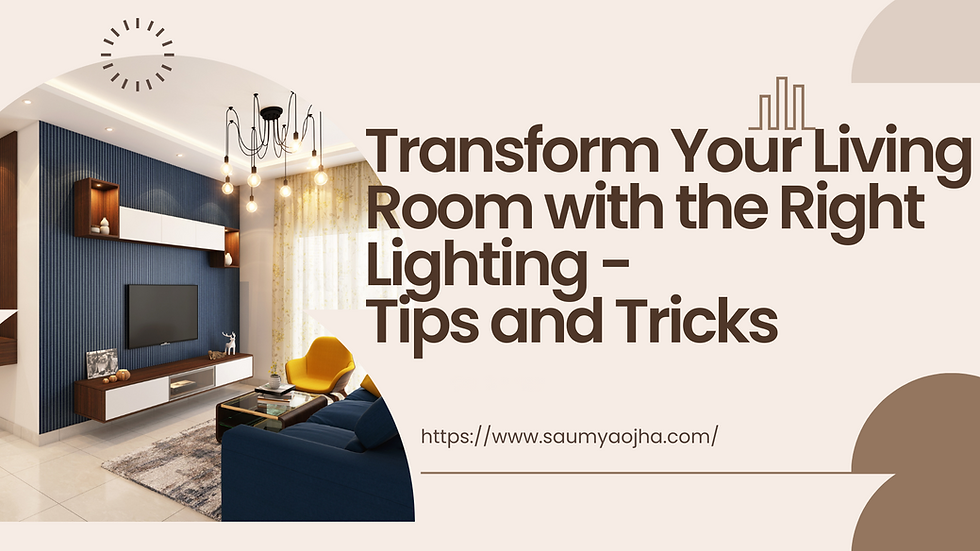Creating Contemporary and Sustainable Interiors for New Age Indian Homeowners
- Saumya Ojha

- Sep 3, 2023
- 4 min read

The process of designing the interiors of a new home can be both exhilarating and daunting, especially for first-time Indian homeowners in the new age. With an increasing focus on contemporary and sustainable design elements, it's essential to strike a balance between style and eco-conscious choices. In this article, we will explore how new age first-time Indian homeowners can approach designing their home interiors while emphasizing contemporary and modern design aesthetics while keeping sustainability at the forefront. Additionally, we will highlight the invaluable role an experienced interior designer can play in bringing these design ideas to fruition.
Embracing Contemporary Design
Contemporary design is all about simplicity, clean lines, and functionality. For new age Indian homeowners, embracing contemporary design can create a sense of spaciousness and sophistication in their homes. Here are some key elements of contemporary design:
a. Minimalism: Less is more. Keep furniture and decor minimal to create an open and uncluttered space. Opt for sleek and simple furniture with clean lines.
b. Neutral Color Palette: A contemporary design often features a neutral color palette with pops of color for accents. Whites, grays, and earthy tones can be combined with vibrant hues for a modern twist.
c. Open Floor Plans: Removing unnecessary walls can create open and airy spaces that are perfect for contemporary living.
d. Natural Light: Maximize natural light by using large windows or glass doors. This not only enhances the aesthetics but also reduces the need for artificial lighting, promoting sustainability.
Incorporating Sustainable Design Elements
Sustainability is no longer a buzzword but a way of life, and it has become increasingly important in interior design. Here are some ways new age Indian homeowners can incorporate sustainable design elements:
a. Eco-friendly Materials: Opt for sustainable materials such as reclaimed wood, bamboo, cork, and recycled glass for furniture and decor. These materials have a lower environmental impact.
b. Energy-efficient Lighting: Use LED or CFL bulbs, as they consume less energy and last longer. Install smart lighting systems to control energy consumption effectively.
c. Low VOC Paints: Volatile Organic Compounds (VOCs) can be harmful to health and the environment. Choose paints with low or zero VOC content.
d. Eco-friendly Furniture: Invest in furniture made from sustainable materials and manufactured using eco-friendly processes. Consider upcycling or repurposing old furniture to reduce waste.
e. Indoor Plants: Incorporating indoor plants not only adds a touch of nature to your home but also improves indoor air quality and reduces carbon dioxide levels.
Seek Inspiration and Professional Guidance
Designing your home interiors can be an overwhelming task, and it's easy to feel lost amidst the plethora of design options available. Seeking inspiration from interior design magazines, websites, and social media platforms can help you identify your style preferences and gather ideas for your home.
However, while inspiration is essential, professional guidance is invaluable. Experienced interior designers bring a wealth of knowledge and expertise to the table. Here's how they can make a difference:
a. Tailored Design Solutions: Interior designers can create customized design solutions that align with your lifestyle, preferences, and budget. They take your unique needs into account, ensuring that the design is functional and aesthetically pleasing.
b. Budget Management: Designing a home involves various expenses, and it's easy to overspend without proper planning. Interior designers can help you establish a realistic budget and make informed decisions to stay within it.
c. Space Optimization: Interior designers excel at maximizing space utilization, ensuring that every corner of your home is functional and visually appealing. They can work wonders in small spaces.
d. Sustainable Choices: A professional interior designer is well-versed in sustainable design practices and can help you make eco-friendly choices without compromising on style or comfort.
e. Access to Resources: Designers have access to a network of suppliers, craftsmen, and artisans, which can help you source quality materials and furnishings at competitive prices.
f. Project Management: Managing a home interior project involves coordinating various aspects like construction, electrical work, and furniture installation. Interior designers can oversee the entire project, ensuring that everything runs smoothly and according to plan.
Creating Timeless Spaces
While it's essential to stay current with contemporary design trends, it's equally crucial to create interiors that stand the test of time. Here are some tips to ensure your home remains stylish for years to come: a. Classic Elements: Incorporate timeless design elements like neutral color palettes, well-crafted furniture, and quality materials that won't go out of style. b. Flexibility: Choose furniture and decor pieces that can adapt to changing trends. Accessorize with trendy items that can be easily replaced when styles evolve. c. Quality Over Quantity: Invest in high-quality furniture and materials that are built to last. Quality pieces may be more expensive upfront, but they often prove to be cost-effective in the long run. d. Personal Touch: Infuse your personality and unique style into your home decor. Personalized elements are less likely to go out of fashion.
Designing the interiors of a new home can be a delightful journey, especially when guided by contemporary design principles and a commitment to sustainability. New age Indian homeowners can create spaces that are not only aesthetically pleasing but also environmentally responsible. The role of an experienced interior designer cannot be overstated, as they bring expertise, creativity, and a commitment to sustainable practices to the table, making the design process smoother and more fulfilling. In the end, the key is to strike a balance between style and sustainability, creating interiors that not only reflect your taste but also contribute positively to the environment and the well-being of your family.
By embracing contemporary design, incorporating sustainable elements, seeking inspiration, and enlisting the expertise of a seasoned interior designer, you can transform your house into a timeless and eco-friendly home that you'll cherish for years to come.



Comments